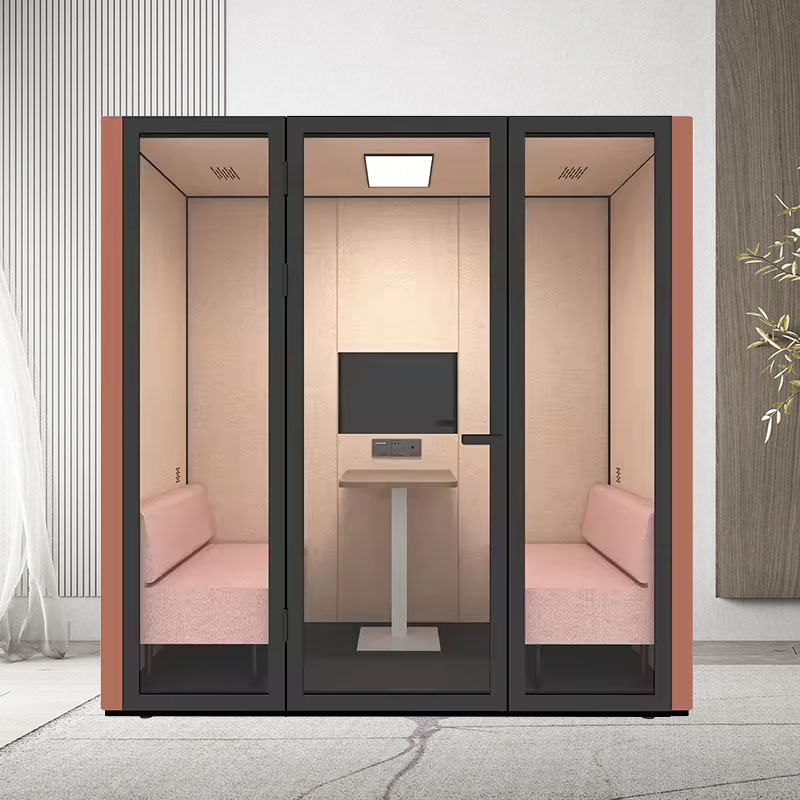Considerations When Choosing a Soundproof Cabin
2024-05-28
A soundproof cabin, also known as an acoustic booth, isolation booth, or soundproof room, is a specialized enclosure designed to minimize the transmission of sound both into and out of the cabin. These cabins are utilized in various applications where sound isolation is crucial, such as recording studios, broadcast facilities, industrial environments, offices, educational institutions, and residential settings.
Key Features:
1. Sound Absorbing Materials:
- Soundproof cabins are constructed using materials with high sound absorption properties, such as acoustic foam panels, fiberglass insulation, mass-loaded vinyl, or soundproofing blankets.
- These materials absorb sound waves and reduce reverberation within the cabin, minimizing the transmission of noise.
2. Double-Walled Construction:
- Many soundproof cabins feature double-walled construction with an air gap between the inner and outer walls.
- The air gap acts as a barrier to sound transmission, further enhancing the cabin's acoustic isolation capabilities.
3. Sealed Doors and Windows:
- Soundproof cabins are equipped with sealed doors and windows to prevent sound leakage.
- Doors may feature heavy-duty seals, gaskets, or automatic door bottoms to ensure a tight seal when closed.
4. Vibration Isolation:
- To prevent vibrations from transmitting through the structure, soundproof cabins may incorporate vibration isolation mounts or pads.
- These isolators decouple the cabin from its surroundings, reducing the transfer of structure-borne noise.
5. Ventilation and HVAC Systems:
- Proper ventilation is essential to maintain air quality and prevent overheating within the cabin.
- Soundproof cabins may be equipped with specialized HVAC systems designed for quiet operation, with noise-reducing components such as duct silencers and low-noise fans.
6. Interior Acoustic Treatment:
- The interior of the cabin may be treated with additional acoustic materials to further improve sound absorption and reduce reflections.
- Acoustic panels, diffusers, and bass traps can be strategically positioned to optimize the cabin's acoustics for specific applications.
Applications:
1. Recording Studios and Broadcast Facilities:
- Soundproof cabins provide a controlled environment for recording vocals, musical instruments, and voiceovers, free from external noise interference.
- Broadcast studios use soundproof cabins for live broadcasts, interviews, and audio recording to ensure high-quality sound reproduction.
2. Industrial Environments:
- In industrial settings, soundproof cabins are used to isolate noisy equipment, machinery, and processes to protect workers and minimize noise pollution.
- These cabins may also serve as control rooms for monitoring operations and communicating with personnel in noisy environments.
3. Office Spaces:
- Soundproof cabins offer private spaces for meetings, phone calls, and focused work in open-plan office environments.
- These cabins provide acoustic privacy and reduce distractions, improving productivity and concentration for office workers.
4. Educational Institutions:
- Soundproof cabins are utilized in schools, colleges, and universities for quiet study areas, testing centers, language labs, and music practice rooms.
- These cabins create conducive environments for learning, concentration, and creative expression without disturbances from external noise.
5. Residential Settings:
- In residential settings, soundproof cabins can be used as home recording studios, home theaters, gaming rooms, or personal retreats.
- These cabins offer privacy and solitude for leisure activities, relaxation, and entertainment without disturbing other household members or neighbors.
Considerations When Choosing a Soundproof Cabin:
1. Size and Configuration:
- Consider the size and layout of the cabin to ensure it meets the space requirements and accommodates the intended use.
- Determine whether additional features such as windows, ventilation, or interior furnishings are needed.
2. Acoustic Performance:
- Evaluate the cabin's acoustic properties, including sound absorption coefficients, noise reduction ratings (NRC), and sound transmission class (STC) ratings.
- Choose a cabin with sufficient acoustic insulation to achieve the desired level of soundproofing for the intended application.
3. Installation and Accessibility:
- Determine whether the cabin can be easily installed and integrated into existing spaces or structures.
- Consider accessibility features such as doors, windows, and interior layout to ensure ease of use and functionality.
4. Ventilation and Comfort:
- Ensure the cabin is equipped with adequate ventilation and climate control systems to maintain comfort and air quality.
- Consider additional features such as lighting, power outlets, and furniture to enhance usability and convenience.
5. Budget and Cost Considerations:
- Evaluate the cost of the soundproof cabin, including materials, construction, and installation, in relation to the available budget.
- Consider long-term value and return on investment in terms of improved acoustic performance, productivity, and user satisfaction.
Popular Brands and Manufacturers:
1. WhisperRoom: Offers a range of prefabricated sound isolation enclosures and booths for recording studios, offices, and industrial applications.
2. ClearSonic: Specializes in modular acrylic panels and enclosures for sound isolation in recording studios, music venues, and live performance spaces.
3. VocalBooth.com: Provides customizable soundproof booths and enclosures for recording, broadcasting, and industrial applications, with options for acoustic treatment and ventilation.
4. Studiobricks: Manufactures modular soundproof cabins and booths for professional recording studios, home theaters, and office environments, with customizable configurations and features.
5. ISOBOX Studios: Offers prefabricated soundproof cabins and isolation booths for recording, broadcasting, and industrial use, with options for custom designs and acoustic treatments.
A soundproof cabin provides a controlled and acoustically isolated environment for various applications, including recording studios, industrial settings, offices, educational institutions, and residential spaces. By incorporating sound-absorbing materials, double-walled construction, sealed doors and windows, vibration isolation, and ventilation systems, these cabins offer effective noise reduction and acoustic privacy, enhancing comfort, productivity, and sound quality for users.



